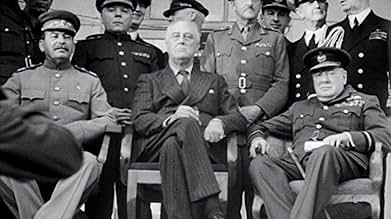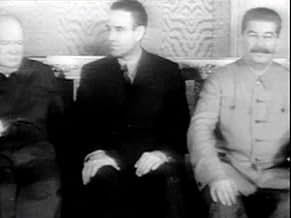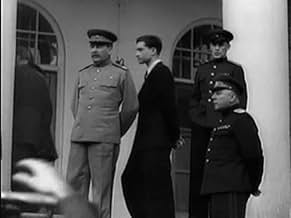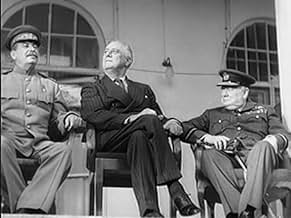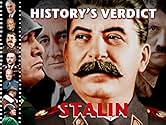Joseph Stalin(1878-1953)
- Additional Crew
Joseph Stalin (a code name meaning "Man of Steel") was born Iosif
(Joseph) Vissarionovich Dzhugashvili in 1878 in Gori, Georgia, the
Transcaucasian part of the Russian Empire. His father was a cobbler
named Vissarion Dzhugashvili, a drunkard who beat him badly and
frequently and left the family when Joseph was young. His mother,
Ekaterina Gheladze, supported herself and her son (her other three
children died young and Jopseph was effectively an only child) by
taking in washing. She managed, despite great hardship, to send Joseph
to school and then on to Tiflis Orthodox Theological Seminary in
Tbilisi, hoping he would become a priest. However, after three years of
studies he was expelled in 1899, for not attending an exam and for
propagating communist ideas and the books of
Karl Marx.
Since 1898, Stalin became active in the Communist underground as the organizer of a powerful gang involved in a series of armed robberies. After robbing several banks in southern Russia, Stalin delivered the stolen money to Vladimir Lenin to finance the Communist Party. Stalin's gang was also involved in the murders of its political opponents; Stalin himself was arrested seven times, repeatedly imprisoned, and twice exiled to Siberia between 1902 and 1913. During those years he changed his name twice and became more closely identified with revolutionary Marxism. He escaped many times from prison and was shuttling money between Lenin and other communists in hiding, where his intimacy with Lenin and Bukharin grew, as did his dissatisfaction with fellow Communist leader Lev Trotskiy. In 1912 he was co-opted on to the illegal Communist Central Committee. At that time he wrote propaganda articles, and later edited the Communist paper, "Pravda" (Truth). As Lenin's apprentice he joined the Communist majority (Bolsheviks), and was responsible for the consolidation of several secret communist cells into a larger ring. Stalin's Communist ring in St. Petersburg and across Russia played the leading role in the Russian Revolution of 1917. After the revolution the Bolsheviks Communists grabbed the power, then Communists murdered the Tsar and the Russian royal family. Stalin and Lenin took over the Tsar's palaces and used the main one in Kremlin as their private residence.
Lenin appointed Stalin the People's Commissar for Nationalities in the first Soviet government and a member of the Communist Politburo, thus giving him unlimited power. Stalin led the "Reds" against anti-Communist forces known as the "Whites" and also in the war with Poland. He also organized "Red Terror" in Tsaritsin (later renamed Stalingrad). With his appointment as General Secretary to the Party Central Committee in 1922, a post he held for the next 30 years, until his death, he consolidated the power that would ensure his control of the country after Lenin's death in 1924. He also took, or gave himself, other key positions that enabled him to amass total power in the Party and Soviet government.
Stalin was known for his piercing eyes and terrifying stare, which he used to cow his opponents into submission during private discussions. In 1927 Stalin requested medical help for his insomnia, anger and severe anxiety disorder. His doctors diagnosed him as having "typical clinical paranoia" and recommended medical treatment. Instead, Stalin became angry and summoned his secret service agents. The next day the chief psychiatrist, Dr. Bekhterev, and his assistants died of poisoning. In addition, before the doctors' diagnosis about Stalin's mental condition could become known, he ordered the executions of intellectuals, resulting in the murders of hundreds of thousands of doctors, professors, writers, and others.
Stalin's policy of amassing dictatorial power under the guise of building "socialism in the country" resulted in brutal extermination of all real and perceived anti-Communist opposition. His purges of the Soviet military brought about the execution of tens of thousands of army officers, many of them experienced combat veterans of the Revolution, the Civil War, the Polish campaigns and other military operations (this decimation of the Russian officer corps would result in the Soviet Union's initial defeats at the hands of Nazi invaders at the beginning of World War II). He also isolated and disgraced his political rivals, notably Trotsky. Stalin's economic policies of strict centralized planning (i.e., the "five-year plans") resulted in the near ruination of the Soviet economy and mass famines in many areas of the Soviet Union, notably in Central Russia and the Ukraine. Popular resistance to Stalin's policies, such as nationalization of private lands and collective farming, by independent farmers ("kulaks"), brought about brutal retaliation, in which millions of kulaks were either forced off their land or executed outright. Altogether Stalin's economic and political policies resulted in the deaths of up to 10 million peasants during 1926-1934. Between 1934 and 1939 he organized and led massive purge (known as "The Great Terror") of the party, government, armed forces and intelligentsia, in which millions of so-called "enemies of the Soviet people" were imprisoned, exiled or executed. In the late 1930s, Stalin sent some Red Army forces and material to support the Spanish Republican government in its fight against the rebels led by Gen. Francisco Franco and aided by troops and material from Nazi Germany and Fascist Italy.
Stalin made the Non-Aggression Pact with Adolf Hitler in 1939, which bought the Soviet Union two years' respite from involvement in World War 2. After the German invasion in 1941, the USSR became a member of the Grand Alliance and Stalin, as war leader, assumed the title of Generalissimus. He had no formal military training and scorned the advice of his senior officers, due to suspicion and his rising paranoia, actions that resulted in horrific losses to the Russian military in both men and material (not to mention civilian losses). He rejected military plans made by such experienced officers as Marshal Georgi Zhukov, and insisted they be replaced by his own plans, which led to even more horrific losses. Towards the end of WWII he took part in the conferences of Teheran, Yalta and Potsdam with Franklin D. Roosevelt, Winston Churchill, Harry S. Truman and Clement Attlee. The agreements reached in those conferences resulted in Soviet military and political control over the liberated countries of postwar Castern and Central Europe.
From 1945 until his death Stalin resumed his repressive measures at home, resulting in censorship of the arts, literature and cinema, forced exiles of hundreds of thousands and the executions of intellectuals and other potential "enemies of the state". At that time he conducted foreign policies that contributed to the Cold War between the Soviet Union and the West. Stalin had little interest in family life, although he was married twice and had several mistresses. His first wife (Ekaterina Svanidze, married c. 1904) died three years after their marriage and left a son, Jacob (also known as Yacov), an officer in the Russian army during World War II who was captured by the Nazis and died in a POW camp (his father refused German offers to exchange him for captured German officers). His second wife (Nadezhda Alliluyeva, married 1919) attempted to moderate his politics, but she died by suicide, leaving a daughter, Svetlana Alliluyeva, and an alcoholic son, Vasili Stalin, who later died in exile. Increasingly paranoid, Stalin launched attacks on such intellectuals as Osip Mandelstam, Vsevolod Meyerhold, Anna Akhmatova, Dmitri Shostakovich, Sergei Prokofiev, Boris Pasternak, Aleksandr Solzhenitsyn and many other cultural luminaries. Stalin personally intervened in the fate of "counterrevolutionary" Yiddish writers and changed their sentences from exile to execution. Thirteen of them were executed by the Soviet secret police; their leader, Perets Markish, was executed in the typical KGB manner by a single gunshot to the head on August 12, 1952, in Moscow.
Stalin died suddenly on March 5, 1953, under somewhat mysterious circumstances, after announcing his intention to arrest Jewish doctors, whom he believed were plotting to kill him. The "official" cause of death was announced as brain hemorrhage. Stalin's apprentice, Georgi Malenkov, took the power, but was soon ousted by Nikita Khrushchev. Three years after death, Stalin was posthumously denounced by Nikita Khrushchev at the 20th Party Congress in 1956 for crimes against the Party and for building a "cult of personality." In 1961 Stalin's body was removed from Lenin's Mausoleum, where it had been displayed since his death, and buried near the Kremlin wall. In 1964 Leonid Brezhnev dismissed Khrushchev and brought back some of Stalin's hard-line policies. After 1986 Mikhail Gorbachev initiated a series of liberal political reforms known as "glasnost" and "perstroika", and many of Stalin's victims were posthumously rehabilitated, and the whole phenomenon of "Stalinism" was officially condemned by the Russian authorities.
Since 1898, Stalin became active in the Communist underground as the organizer of a powerful gang involved in a series of armed robberies. After robbing several banks in southern Russia, Stalin delivered the stolen money to Vladimir Lenin to finance the Communist Party. Stalin's gang was also involved in the murders of its political opponents; Stalin himself was arrested seven times, repeatedly imprisoned, and twice exiled to Siberia between 1902 and 1913. During those years he changed his name twice and became more closely identified with revolutionary Marxism. He escaped many times from prison and was shuttling money between Lenin and other communists in hiding, where his intimacy with Lenin and Bukharin grew, as did his dissatisfaction with fellow Communist leader Lev Trotskiy. In 1912 he was co-opted on to the illegal Communist Central Committee. At that time he wrote propaganda articles, and later edited the Communist paper, "Pravda" (Truth). As Lenin's apprentice he joined the Communist majority (Bolsheviks), and was responsible for the consolidation of several secret communist cells into a larger ring. Stalin's Communist ring in St. Petersburg and across Russia played the leading role in the Russian Revolution of 1917. After the revolution the Bolsheviks Communists grabbed the power, then Communists murdered the Tsar and the Russian royal family. Stalin and Lenin took over the Tsar's palaces and used the main one in Kremlin as their private residence.
Lenin appointed Stalin the People's Commissar for Nationalities in the first Soviet government and a member of the Communist Politburo, thus giving him unlimited power. Stalin led the "Reds" against anti-Communist forces known as the "Whites" and also in the war with Poland. He also organized "Red Terror" in Tsaritsin (later renamed Stalingrad). With his appointment as General Secretary to the Party Central Committee in 1922, a post he held for the next 30 years, until his death, he consolidated the power that would ensure his control of the country after Lenin's death in 1924. He also took, or gave himself, other key positions that enabled him to amass total power in the Party and Soviet government.
Stalin was known for his piercing eyes and terrifying stare, which he used to cow his opponents into submission during private discussions. In 1927 Stalin requested medical help for his insomnia, anger and severe anxiety disorder. His doctors diagnosed him as having "typical clinical paranoia" and recommended medical treatment. Instead, Stalin became angry and summoned his secret service agents. The next day the chief psychiatrist, Dr. Bekhterev, and his assistants died of poisoning. In addition, before the doctors' diagnosis about Stalin's mental condition could become known, he ordered the executions of intellectuals, resulting in the murders of hundreds of thousands of doctors, professors, writers, and others.
Stalin's policy of amassing dictatorial power under the guise of building "socialism in the country" resulted in brutal extermination of all real and perceived anti-Communist opposition. His purges of the Soviet military brought about the execution of tens of thousands of army officers, many of them experienced combat veterans of the Revolution, the Civil War, the Polish campaigns and other military operations (this decimation of the Russian officer corps would result in the Soviet Union's initial defeats at the hands of Nazi invaders at the beginning of World War II). He also isolated and disgraced his political rivals, notably Trotsky. Stalin's economic policies of strict centralized planning (i.e., the "five-year plans") resulted in the near ruination of the Soviet economy and mass famines in many areas of the Soviet Union, notably in Central Russia and the Ukraine. Popular resistance to Stalin's policies, such as nationalization of private lands and collective farming, by independent farmers ("kulaks"), brought about brutal retaliation, in which millions of kulaks were either forced off their land or executed outright. Altogether Stalin's economic and political policies resulted in the deaths of up to 10 million peasants during 1926-1934. Between 1934 and 1939 he organized and led massive purge (known as "The Great Terror") of the party, government, armed forces and intelligentsia, in which millions of so-called "enemies of the Soviet people" were imprisoned, exiled or executed. In the late 1930s, Stalin sent some Red Army forces and material to support the Spanish Republican government in its fight against the rebels led by Gen. Francisco Franco and aided by troops and material from Nazi Germany and Fascist Italy.
Stalin made the Non-Aggression Pact with Adolf Hitler in 1939, which bought the Soviet Union two years' respite from involvement in World War 2. After the German invasion in 1941, the USSR became a member of the Grand Alliance and Stalin, as war leader, assumed the title of Generalissimus. He had no formal military training and scorned the advice of his senior officers, due to suspicion and his rising paranoia, actions that resulted in horrific losses to the Russian military in both men and material (not to mention civilian losses). He rejected military plans made by such experienced officers as Marshal Georgi Zhukov, and insisted they be replaced by his own plans, which led to even more horrific losses. Towards the end of WWII he took part in the conferences of Teheran, Yalta and Potsdam with Franklin D. Roosevelt, Winston Churchill, Harry S. Truman and Clement Attlee. The agreements reached in those conferences resulted in Soviet military and political control over the liberated countries of postwar Castern and Central Europe.
From 1945 until his death Stalin resumed his repressive measures at home, resulting in censorship of the arts, literature and cinema, forced exiles of hundreds of thousands and the executions of intellectuals and other potential "enemies of the state". At that time he conducted foreign policies that contributed to the Cold War between the Soviet Union and the West. Stalin had little interest in family life, although he was married twice and had several mistresses. His first wife (Ekaterina Svanidze, married c. 1904) died three years after their marriage and left a son, Jacob (also known as Yacov), an officer in the Russian army during World War II who was captured by the Nazis and died in a POW camp (his father refused German offers to exchange him for captured German officers). His second wife (Nadezhda Alliluyeva, married 1919) attempted to moderate his politics, but she died by suicide, leaving a daughter, Svetlana Alliluyeva, and an alcoholic son, Vasili Stalin, who later died in exile. Increasingly paranoid, Stalin launched attacks on such intellectuals as Osip Mandelstam, Vsevolod Meyerhold, Anna Akhmatova, Dmitri Shostakovich, Sergei Prokofiev, Boris Pasternak, Aleksandr Solzhenitsyn and many other cultural luminaries. Stalin personally intervened in the fate of "counterrevolutionary" Yiddish writers and changed their sentences from exile to execution. Thirteen of them were executed by the Soviet secret police; their leader, Perets Markish, was executed in the typical KGB manner by a single gunshot to the head on August 12, 1952, in Moscow.
Stalin died suddenly on March 5, 1953, under somewhat mysterious circumstances, after announcing his intention to arrest Jewish doctors, whom he believed were plotting to kill him. The "official" cause of death was announced as brain hemorrhage. Stalin's apprentice, Georgi Malenkov, took the power, but was soon ousted by Nikita Khrushchev. Three years after death, Stalin was posthumously denounced by Nikita Khrushchev at the 20th Party Congress in 1956 for crimes against the Party and for building a "cult of personality." In 1961 Stalin's body was removed from Lenin's Mausoleum, where it had been displayed since his death, and buried near the Kremlin wall. In 1964 Leonid Brezhnev dismissed Khrushchev and brought back some of Stalin's hard-line policies. After 1986 Mikhail Gorbachev initiated a series of liberal political reforms known as "glasnost" and "perstroika", and many of Stalin's victims were posthumously rehabilitated, and the whole phenomenon of "Stalinism" was officially condemned by the Russian authorities.



